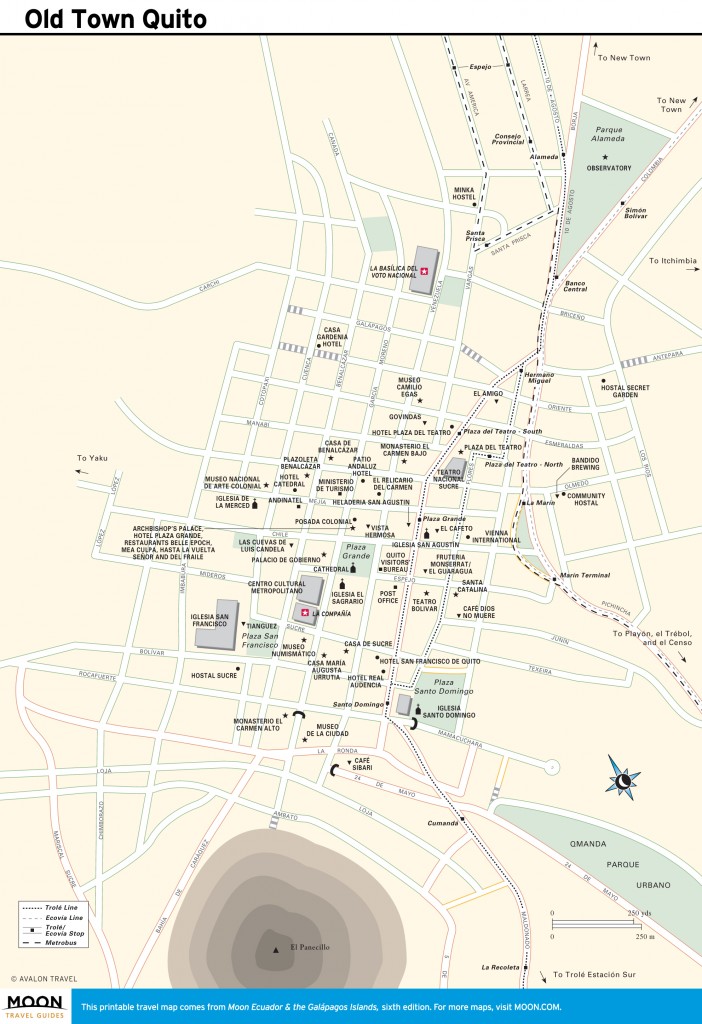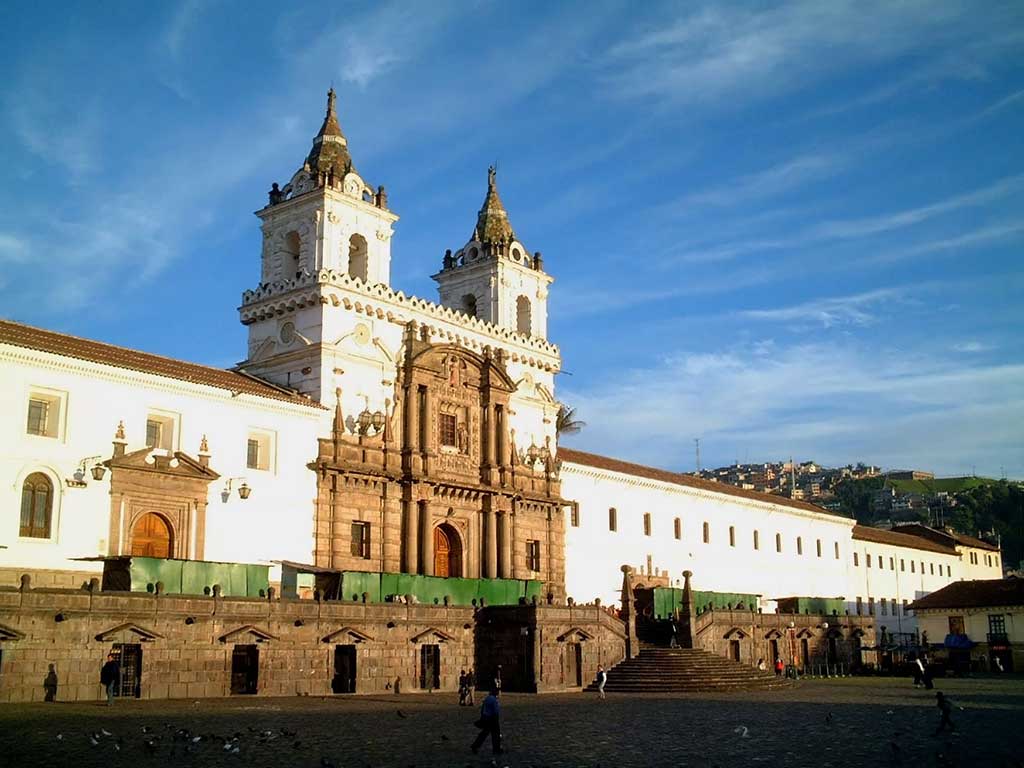Quito’s Old Town is what makes the city famous, containing a huge number of colonial churches and religious buildings set around elegant plazas. The walls and ceilings are decorated with elaborate paintings and sculptures, and altars are resplendent with gold leaf.
Flash photography is prohibited in most churches and historical museums to protect the fragile pigments of the religious paintings and statues. Keep in mind that opening hours fluctuate regularly; those provided here are the latest available. Several churches are currently undergoing extensive renovation work, but all are open.
Quito’s Old Town is cleaner, safer, and a joy to wander around following a recent multimillion-dollar regeneration. Gone are the beggars and street vendors, replaced with police and horse-drawn carriages carting visitors around churches, which are beautifully lit at night. A system called Pico y Placa regulates traffic congestion by restricting the entry of certain license-plate numbers at peak hours. It has improved the traffic situation, although the narrow streets still struggle to accommodate Quito’s cars. Cars are prohibited completely 9am-4pm Sunday, making it the most pleasant day for sightseeing.
![Old Town Quito, Ecuador. Photo © Albert Backer (Own work) [CC BY-SA 3.0], via Wikimedia Commons](https://www.holidaytravel.cc/Article/UploadFiles/201602/2016021615085641.jpg)
Old Town Quito, Ecuador. Photo © Albert Backer (Own work) [CC BY-SA 3.0], via Wikimedia Commons.
The municipality of Quito has put together excellent guided maps to historic walks through Old Town, available at tourist offices. Even better are the multilingual tours given by municipal police from the tourist office.This ornate 16th-century plaza is the political focal point of colonial Quito. Officially called the Plaza de la Independencia, it features a winged statue to independence atop a high pillar. The surrounding park is a popular gathering place with regular music, mime, and dance performances.
On the plaza’s southwest side, the Catedral is actually the third to stand on this site (mass 6am-9am daily). Other visits are available through the museum located on Venezuela (tel. 2/257-0371, 9:30am-4pm Mon.-Fri., 10am-4pm Sun., $1.50). Hero of independence Antonio José de Sucre is buried here. Behind the main altar is the smaller altar of Nuestra Señora de Los Dolores, where, on August 6, 1875, president Gabriel García Moreno drew his last breath after being attacked with machetes outside the presidential palace. He is now buried here also, as is the country’s first president, Juan José Flores.
![Plaza de la Independencia. Photo © Cayambe (Own work) [<a href="http://creativecommons.org/licenses/by-sa/3.0">CC BY-SA 3.0</a> or <a href="http://www.gnu.org/copyleft/fdl.html">GFDL</a>], <a href="https://commons.wikimedia.org/wiki/File%3AQuito_pl_de_la_Independencia_2006_01.jpg">via Wikimedia Commons</a>.](https://www.holidaytravel.cc/Article/UploadFiles/201602/2016021615085664.jpg)
Plaza de la Independencia. Photo © Cayambe (Own work) [CC BY-SA 3.0 or GFDL], via Wikimedia Commons.
Next door, formerly the main chapel of the cathedral, the Iglesia El Sagrario (7:30am-6pm Mon.-Sat., 7:30am-noon Sun.) was begun in 1657 and completed half a century later. The walls and ceiling of the short nave are painted to simulate marble—even the bare stone is speckled black-and-white. Impressive paintings and stained glass windows decorate the center cupola. Bernardo de Legarda, the most outstanding Quiteño sculptor of the 18th century, carved and gilded the baroque mampara (partition) inside the main doorway.A long, arched atrium to the northwest lines the front of the handsome Palacio Presidencial (9am-noon and 3pm-5pm Tues.-Sun., free tours when the government is not in session), also known as El Carondelet. The ironwork on the balconies over the plaza, originally from the Tuileries Palace in Paris, was purchased just after the French Revolution. Current president Rafael Correa opened the doors of the palace to daily visitors in 2007, and it’s worth making a line for the guided tours of the interior that leave every hour or so.
The Palacio Arzobispal (Archbishop’s Palace) on the northeast side leads to a three-story indoor courtyard housing a number of small shops and eateries. Cobbled courtyards, thick whitewashed walls, and wooden balconies make it worth a look. The plaza’s colonial spell is broken only by the modern City Hall to the southeast. The church of La Concepción (10am-4pm Mon.-Fri., 10am-2pm Sat.-Sun.) stands at the corner of Chile and García Moreno. The attached convent is Quito’s oldest, dating to 1577, and is closed to visitors.
At the corner of Benalcázar and Espejo, the Centro Cultural Metropolitano (tel. 2/295-0272, 9am-4:30pm daily) houses the collection of the Museo Alberto Mena Caamaño (tel. 2/258-4362, 9am-5pm Tues.-Sun., $1.50), which includes colonial and contemporary art and a set of wax figures depicting the death throes of patriots killed in 1810 by royalist troops. The cultural center also includes lecture rooms, the municipal library, and gallery space for temporary art exhibits.

Old Town Quito
La Compañía (9:30am-6:30pm Mon.-Thurs., 9:30am-5:30pm Fri., 9:30am-4pm Sat.,12:30pm-4pm Sun., $3) is one of the most beautiful churches in the Americas and certainly the most extravagant. Seven tons of gold supposedly ended up on the ceiling, walls, and altars of “Quito’s Sistine Chapel,” which was built by the wealthy Jesuit order between 1605 and 1765. The church has been restored from the damage caused by the 1987 earthquake and a raging fire in 1996. It is a glorious example of human endeavor but at the same time borders on opulence gone mad.
Even the outside is overwhelming, crammed with full-size statues, busts, and sculpted hearts. The interior has eight side chapels, one of which houses the guitar and possessions of Quito’s first saint, Santa Mariana de Jesús—her remains are under the main altar. Some of the more expensive relics, including a painting of the Virgin framed with gold and precious stones, are locked away in a bank vault between festivals. One of the more eye-catching objects in La Compañía is a painting depicting hell, where sinners—each labeled with one of the deadly sins—receive excruciating punishments.
Across Sucre from La Compañía is the Museo Numismático (tel. 2/258-9284, 9am-1pm and 2pm-5pm Tues.-Fri., 10am-1pm and 2pm-4pm Sat.-Sun., $1), which traces the history of Ecuador’s various currencies, from shell currency to the adoption of the U.S. dollar. An inflation chart shows just how bad the economic situation used to be, before dollarization stabilized it in the last decade. Also housed here is the national music library, where there are often free concerts in the evenings. On the opposite side of García Moreno from the museum is the Casa de María Augusta Urrutia (García Moreno 760, between Sucre and Bolívar, tel. 2/258-0103, 10am-6pm Tues.-Sat., 9:30am-5:30pm Sun., $2), a wonderfully preserved 19th-century mansion. Doña María passed away in 1987, and her house is a virtual window on the past, with three inner patios and luxurious accoutrements from all over the globe, as well as a gallery of Victor Mideros’s paintings.
Heading east on Sucre brings you to the Casa de Sucre (Venezuela 513 at Sucre), once home to Simón Bolívar’s southern counterpart. The building has been preserved in its original state from the early 1800s, and the collection focuses on military history.
Turn right up the hill past La Compañía to one of Ecuador’s most beautiful squares, Plaza San Francisco. This wide cobbled expanse is a highlight of the city, dominated by the wide facade of the Iglesia San Francisco (9am-5:30pm Mon.-Sat., 9am-1pm Sun.), the oldest colonial edifice in the city and the largest religious complex in South America. It was begun on the site of an Inca royal house within weeks of the city’s founding in 1534. The first wheat grown in Ecuador sprouted in one of its courtyards, and Atahualpa’s children received their education in its school.

Iglesia San Francisco in Old Town Quito. Photo © Paul Prescott/123rf.
Two white spires flank a glowering stone facade, which sets the perfect mood for the interior. Inside, it’s easy to imagine yourself in the 16th century, with the musty odor drifting up from the creaking wooden floorboards. Thick encrustations of gold cover almost every surface, and seeing the carved roof alone is worth a visit. Notice how many of the design motifs come from indigenous cultures, including the smiling and frowning faces of sun gods, repeated several times, and harvest symbols of flowers and fruit. At the time of this writing, the altar of the church was still undergoing a long and painstaking multiple-year restoration. Don’t miss the choir rooms upstairs at the back of the church, adorned by statues of monks and the original wooden ceilings (enter through the museum).
To the right of the main entrance, the Museo Fray Pedro Gocial (tel. 2/228/1124, 9am-5:30pm Mon.-Sat., 9am-12:30pm Sun., $2) houses one of the finest collections of colonial art in Quito, dating from the 16th-19th centuries. Guided tours are included in English, Spanish, and French. A highlight is the seven-meter-high portrait of the Franciscan family tree on the stairs leading up to the choir room.
On the other side, the Capilla de Catuña (8am-noon and 3pm-6pm daily) also has colonial art on display. The story goes that this chapel was constructed by an indigenous man named Catuña who promised to have it completed in a certain amount of time. When it became obvious that he wasn’t going to come close to his deadline, he offered his soul to the devil in exchange for help getting the job done. Catuña finished but had a sudden change of heart, begging the Virgin Mary to save him from his hasty agreement. Sure enough, a foundation stone was discovered missing during the inauguration, negating his deal with the devil.
The Tianguez café and gift shop downstairs is a great place to overlook the plaza with a coffee and a snack.
Excerpted from the Sixth Edition of Moon Ecuador & the Galapagos Islands/.